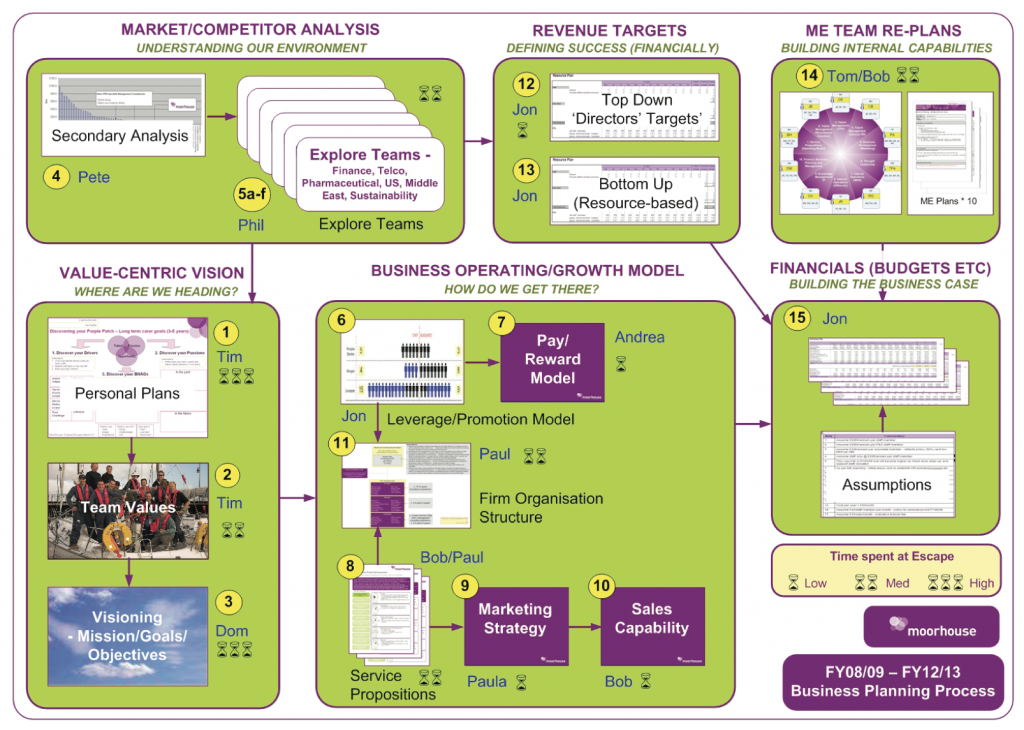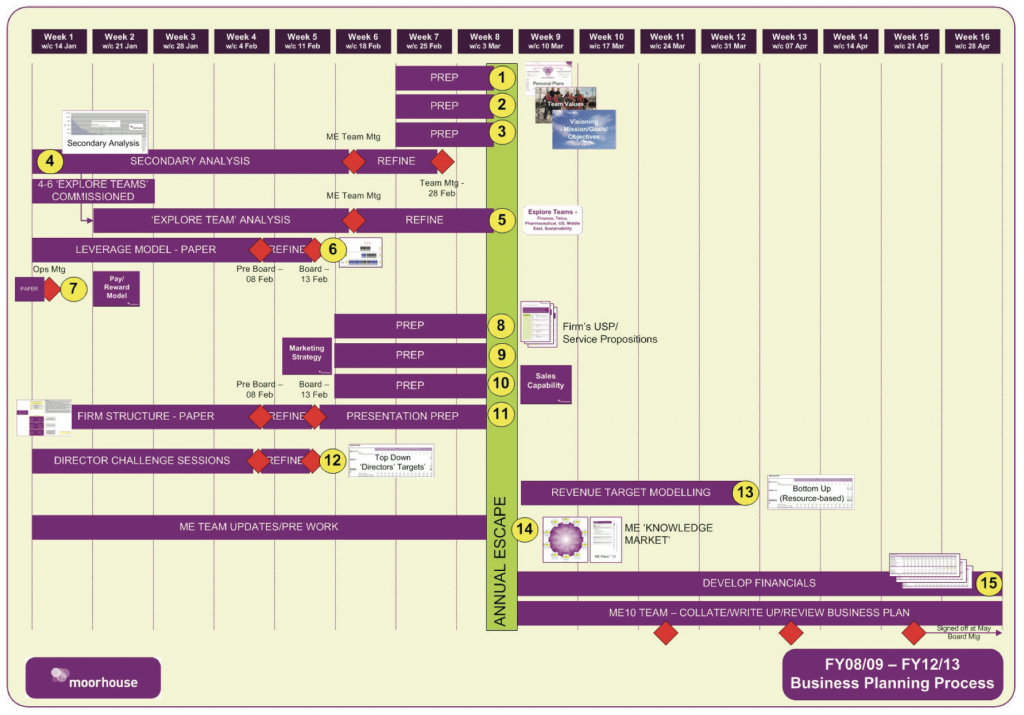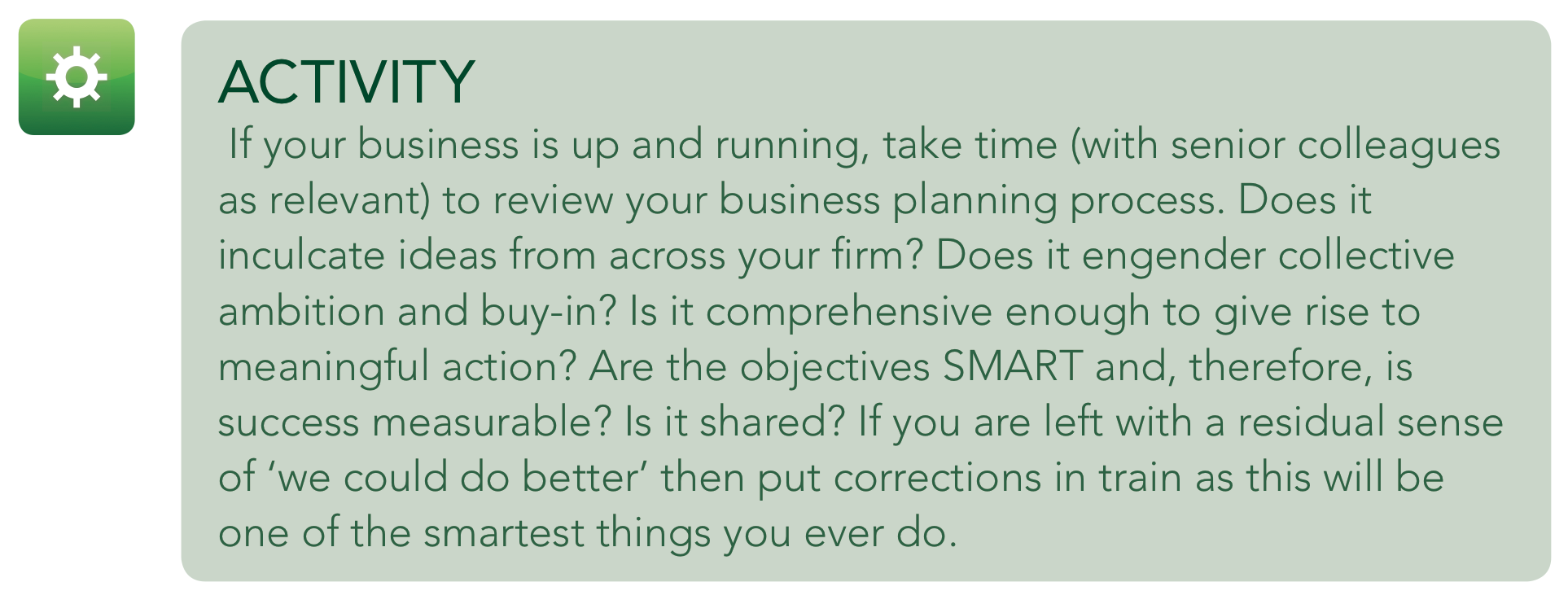Developing a business planning process

Photo Credit: social.englishme via Compfight cc
Alas, the essential start-up plan is likely to involve just yourself as the sole author. As your business grows, however, I am strongly advocating that you develop a collaborative planning ethos and capability that includes your entire team. Well coordinated, such an approach is eminently feasible even with large numbers of staff (certainly up to, say, eighty people). The fundamental value of this exercise – as I hope I am making clear now – is all the shared discussion, alignment and buy-in that occurs as a function of this communal activity en route. A plan will always need a final author, or a few controlling minds, to give it an overall coherence and direction but, that said, this team approach is not just a contrived ‘hearts and minds’ exercise. Conversely, opening up the exercise to all your colleagues will invariably broaden and enrich the idea generation (and the quality of thinking overall) as well as priming the engagement levels needed to deliver it. Regardless, therefore, as to whether you are a singleton or eighty-strong, you should seek now to configure and embed a repeatable planning process.
A simple way of coming at this is to agree the structure of your company plan (as per the previous blog). If you are more than a singleton, then allocate col- leagues to different elements as fits their own interest and expertise. The process of building the plan then consists of iterations of work done by these sub-teams (to research, explore and propose sub-plans) with collective ‘integrate and re- view’ sessions (as clearly the plan needs to work as a coherent, aggregate whole). By way of illustration, in the early years at Moorhouse, the ME10 Team (‘Finance, Business Planning and Management’) owned the objective of building a planning capability and producing the annually revised plan. They would initially develop a process and timeline by which everyone in the firm would be allocated to a component of this exercise.
Typically, this would be a four-month exercise pivoting around our annual out-of-country, team ‘Escape’ (when all the preceding research and draft plans would be brought together, discussed and refined collectively). Thereafter, the final plan would be collated and reviewed by our Board for sign-off, base-lining and distribution. It should be noted that this was four months of elapsed time with the actual work being very part-time and ‘in the margins’ of client delivery (for example, during end-of-the-day sessions back at the office).
The figures below illustrate how we went about the decomposition of plan elements (assigned to sub-teams with a clear lead owner), and the high-level timeline for bringing it all together, during an actual year of practice at Moorhouse.
It is, perhaps, worth drawing out some elements of this process – as per our practice of it.
First of all, it did evolve; no one year was exactly the same. Rather, key principles were maintained – such as small-team project oversight, whole-team involvement, clear pre-communication of elements and timeline, the bringing together at the annual escape, firm-wide dissemination of plan etc.
You will also note, from the figure above, that we took the exercise right down to a personal plan level. At our Escape event – away from the distractions of everyday demands – everyone was encouraged to revisit and make a record of their personal objectives. We would encourage such exercises to be holistic (career, health, personal development, relationships with family/friends etc) and honest. With regards to career ambition, we celebrated the integrity of everyone’s different ambitions; it didn’t matter that Moorhouse might just be a transient stepping stone along their professional journey. If, indeed, someone said they wanted to set up their own business in due course, and that time with Moorhouse was about ‘learning the ropes’, we would say ‘great, join the business planning team to really get some insights that will be useful for you in this future’. This uncontrived, grown-up conversation meant that we were left with a real understanding of how best to match people-to-task (minded of their talents and ambitions).
Hopefully, you also spotted the key section focused on building our internal capabilities – as per my previous blog on these ‘Multiple Enhancers’. Part 3 of my book series, ‘Building’, will give you all the ideas and insights you need to populate these plans. Suffice to say in this section that everyone in the firm was allocated to one of these project teams and charged with developing their sub-plan (details on which I cover in a ‘Strategy and Execution’ future blog).
As we grew, so an organisational emphasis switched to industry sectors (e.g. Government, Transport, Health, Pharmaceuticals, Financial Services etc). Planning by sector became essential and, accordingly, everyone in the firm was allocated to one such sector planning team. I would commend, however, that you start with a narrow sector focus and only introduce this discipline when you have built foundations.
So, in summary, this is all for you to configure. Firstly, nominate a team to design and drive the process. Under your lead (this is one of the key efforts you really shouldn’t delegate – not in the early years at least), design the plan’s structure, decompose this into its key elements and allocate these out to whole-firm involvement. Typically, the business planning team might take on the core sections (market/competitor analysis, financials etc) but everyone should play a part in developing, say, sector and capability-build plans. Bring it all together at a whole-firm communication event such that sub-plans can be peer-reviewed, challenged and elements ‘stitched together’. Finally, time-box the whole process such that the resultant plan has a defined start-point (clearly, it makes sense to align this with your financial year).
————
If you are interested in re-charging your business ambition/strategy/plans, Dom runs his (three-day) Five-Year Entrepreneur Retreat twice a year (March, September) – see here for previous delegate testimonials and details on future presentations. If you would like to make a reservation (capped to 14 attendees per Retreat) please drop a line via the contact page.




